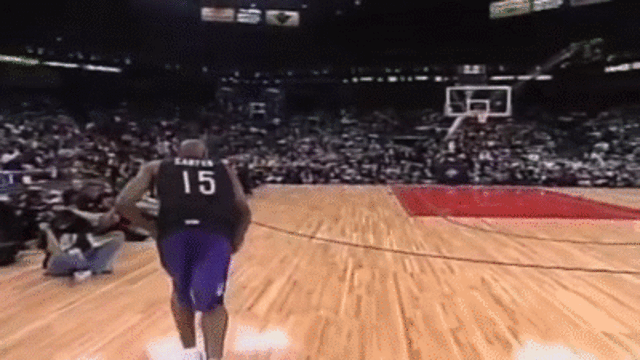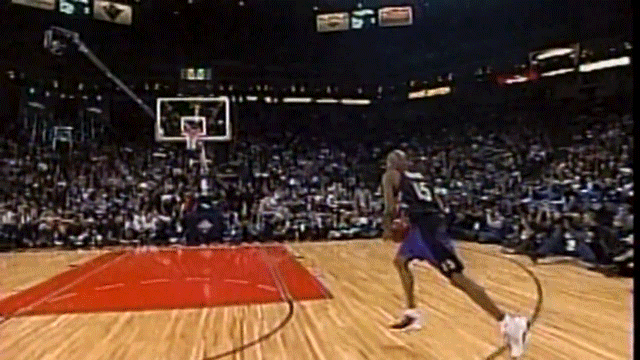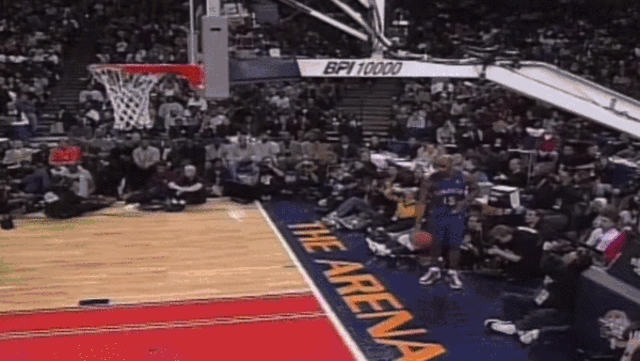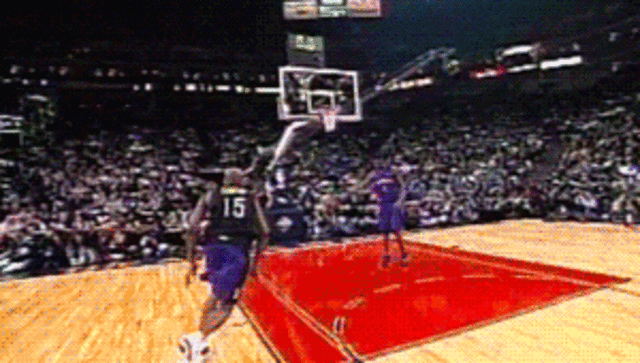Photo by Reuters
This article originally appeared on VICE Sports Canada.I could not figure out what he had just done. It didn't compute. Most people who were watching Vince Carter's fourth dunk on a Saturday night in Oakland in February 2000 were with me, too."Wait. Timeout. Timeout," TNT analyst Kenny Smith exclaimed after the dunk in question. "Can I take a timeout? Can we take a timeout? Can I take a timeout?"Carter had already amazed on All-Star Saturday night with a combination of athleticism and power that was plainly unfair. On his first three dunks, he had received 149 points out of a possible 150, throwing down two of the greatest jams we had ever seen. He had wowed everybody, but now he was going for something post-modern. By completing a tomahawk dunk and then sticking his forearm down through the rim, hanging by the inside of his elbow, Carter was deconstructing the contest.He had set Oracle Arena ablaze with his first three efforts; you will remember the dumbfounded, exuberant grins of Shaquille O'Neal and Kevin Garnett, partially obscured by their camcorders. (Sixteen years is a long time, technologically speaking.) With this effort, Carter purposely tried to silence the crowd. That he could achieve that goal, on a night that is defined by over-the-top sizzle, was incredible. What Carter did that night was so cool.A few months later, that dunk had still left an impression with 15-year-old me. I lowered my friend's hoop on his suburban driveway considerably, and aimed to mimic Carter's "elbow dunk." I completed the attempt, sure, but irreparably bent the rim and bruised my forearm in the process. It was, errrr, less cool.
He had wowed everybody, but now he was going for something post-modern. By completing a tomahawk dunk and then sticking his forearm down through the rim, hanging by the inside of his elbow, Carter was deconstructing the contest.He had set Oracle Arena ablaze with his first three efforts; you will remember the dumbfounded, exuberant grins of Shaquille O'Neal and Kevin Garnett, partially obscured by their camcorders. (Sixteen years is a long time, technologically speaking.) With this effort, Carter purposely tried to silence the crowd. That he could achieve that goal, on a night that is defined by over-the-top sizzle, was incredible. What Carter did that night was so cool.A few months later, that dunk had still left an impression with 15-year-old me. I lowered my friend's hoop on his suburban driveway considerably, and aimed to mimic Carter's "elbow dunk." I completed the attempt, sure, but irreparably bent the rim and bruised my forearm in the process. It was, errrr, less cool. Raptors fans, and Torontonians in general, had never felt especially cool. Fast forward to this coming weekend, when the Raptors, the second-best team in the Eastern Conference with a thriving brand and a superstar global ambassador, will host the NBA's All-Star Weekend for the first time. A lot has changed.In the Raptors' expansion era, the team's supporters backed a team which had an immediately outdated nickname and pathetic on-court results, marked by lots of losses, three head coaches, two general managers, a star who demanded a trade and a failed ownership coup. It could have been worse—see their compatriot expansion cousins in Vancouver—but the Raptors' early days were unrelentingly bleak, or close enough.Likewise, until recently, there was very little that was cool about Toronto. Aside from the occasional story about the hipness of Queen West, Toronto was either seen as a poor man's New York or culturally deficient compared to Montreal. The city's sports obsession, the Maple Leafs, were a frequent laughing stock with fits of promise. The Blue Jays won back-to-back World Series titles in 1992 and 1993, but the strike and an immediately outdated stadium took the wind out of their sails for the next two decades. (If you're looking for the coolest pre-Vince Toronto sports moment, Roberto Alomar immediately celebrating a home run that barely cleared the wall off of Dennis Eckersley in the 1992 American League Championship Series is a good candidate.) There was little about Toronto that permeated the continental consciousness.Which is not to say there is a throughline from Carter's Oakland exploits to, well, Drake, but his efforts that night really resonated. They were certainly a key part of the area's contribution to the NBA talent pool—nine players born and raised from the Greater Toronto Area have entered the NBA since 2011, and Andrew Wiggins, Anthony Bennett, Tyler Ennis and Cory Joseph have all spoken about how transformative that evening in particular was. Terrence Ross wore Carter's Raptors jersey for a dunk a few years back when he won the contest in far less memorable fashion.The impact of Carter's performance always went beyond him simply winning. A few interviews Carter has done recently indicate that his win that night was not the result of endless scripting and tweaking.For a while after Carter's win, the dunk contest became defined by the use of props, and the attempts seemed cooked up in a laboratory or in front of a focus group. Instead, Carter was improvising, a Curb Your Enthusiasm-spirited effort without any of the intended awkwardness.
Raptors fans, and Torontonians in general, had never felt especially cool. Fast forward to this coming weekend, when the Raptors, the second-best team in the Eastern Conference with a thriving brand and a superstar global ambassador, will host the NBA's All-Star Weekend for the first time. A lot has changed.In the Raptors' expansion era, the team's supporters backed a team which had an immediately outdated nickname and pathetic on-court results, marked by lots of losses, three head coaches, two general managers, a star who demanded a trade and a failed ownership coup. It could have been worse—see their compatriot expansion cousins in Vancouver—but the Raptors' early days were unrelentingly bleak, or close enough.Likewise, until recently, there was very little that was cool about Toronto. Aside from the occasional story about the hipness of Queen West, Toronto was either seen as a poor man's New York or culturally deficient compared to Montreal. The city's sports obsession, the Maple Leafs, were a frequent laughing stock with fits of promise. The Blue Jays won back-to-back World Series titles in 1992 and 1993, but the strike and an immediately outdated stadium took the wind out of their sails for the next two decades. (If you're looking for the coolest pre-Vince Toronto sports moment, Roberto Alomar immediately celebrating a home run that barely cleared the wall off of Dennis Eckersley in the 1992 American League Championship Series is a good candidate.) There was little about Toronto that permeated the continental consciousness.Which is not to say there is a throughline from Carter's Oakland exploits to, well, Drake, but his efforts that night really resonated. They were certainly a key part of the area's contribution to the NBA talent pool—nine players born and raised from the Greater Toronto Area have entered the NBA since 2011, and Andrew Wiggins, Anthony Bennett, Tyler Ennis and Cory Joseph have all spoken about how transformative that evening in particular was. Terrence Ross wore Carter's Raptors jersey for a dunk a few years back when he won the contest in far less memorable fashion.The impact of Carter's performance always went beyond him simply winning. A few interviews Carter has done recently indicate that his win that night was not the result of endless scripting and tweaking.For a while after Carter's win, the dunk contest became defined by the use of props, and the attempts seemed cooked up in a laboratory or in front of a focus group. Instead, Carter was improvising, a Curb Your Enthusiasm-spirited effort without any of the intended awkwardness. "Right before I grabbed the basketball from the referee for my first dunk, I didn't know what I was going to do. I really didn't know," Carter told Dave Zarum in his excellent oral history of the night for Sportsnet. "So I thought, What do I want to accomplish with the look? I'm looking for creativity, hang time, and all the things I had been studying many years before. All of these years are coming into one night, one moment. And here I am, minutes before it's my chance to show the world, and it's just like, Oh gosh, what should I do here?"That evening, Carter unleashed three dunks that will go down as among the greatest ever: his first attempt, a 360 windmill; his third attempt, which he put through his legs after catching a bounce pass from teammate Tracy McGrady—a dunk inspired by a magazine advertisement—and the elbow dunk.
"Right before I grabbed the basketball from the referee for my first dunk, I didn't know what I was going to do. I really didn't know," Carter told Dave Zarum in his excellent oral history of the night for Sportsnet. "So I thought, What do I want to accomplish with the look? I'm looking for creativity, hang time, and all the things I had been studying many years before. All of these years are coming into one night, one moment. And here I am, minutes before it's my chance to show the world, and it's just like, Oh gosh, what should I do here?"That evening, Carter unleashed three dunks that will go down as among the greatest ever: his first attempt, a 360 windmill; his third attempt, which he put through his legs after catching a bounce pass from teammate Tracy McGrady—a dunk inspired by a magazine advertisement—and the elbow dunk. What remains amazing about all of those dunks is it really seemed that Carter was not straining to complete them. Could he have added another half-rotation on the first try? Could he have added some extra pizzaz to the third dunk? Could he have swung from his elbow a few more times, just to emphasize the absurdity of his gifts? I would not have bet against him in that moment, which is why it is almost shocking to hear him talking about struggling with lesser dunks in the leadup to the night. How could the athleticism of that guy be thwarted?Better yet, he was revelling in his own excellence. The stakes were much lower, but Carter mouthing "It's over" midway through the contest and Jose Bautista's October bat flip were not dissimilar. Toronto was a hockey town, and (sometimes false) humility is king in that sport. Carter's boastfulness and unfathomable dominance stood in contrast to that. At the time, it did not seem like a very Toronto moment.Sixteen years on, it sure does.
What remains amazing about all of those dunks is it really seemed that Carter was not straining to complete them. Could he have added another half-rotation on the first try? Could he have added some extra pizzaz to the third dunk? Could he have swung from his elbow a few more times, just to emphasize the absurdity of his gifts? I would not have bet against him in that moment, which is why it is almost shocking to hear him talking about struggling with lesser dunks in the leadup to the night. How could the athleticism of that guy be thwarted?Better yet, he was revelling in his own excellence. The stakes were much lower, but Carter mouthing "It's over" midway through the contest and Jose Bautista's October bat flip were not dissimilar. Toronto was a hockey town, and (sometimes false) humility is king in that sport. Carter's boastfulness and unfathomable dominance stood in contrast to that. At the time, it did not seem like a very Toronto moment.Sixteen years on, it sure does.
READ MORE: Why the Surging Raptors Don't Need to Rush the Process
Advertisement


Advertisement
Advertisement

